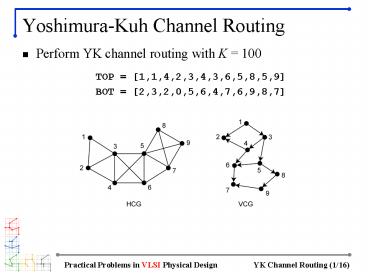Yoshimura-Kuh Channel Routing PowerPoint PPT Presentation
Title: Yoshimura-Kuh Channel Routing
1
Yoshimura-Kuh Channel Routing
- Perform YK channel routing with K 100
- TOP 1,1,4,2,3,4,3,6,5,8,5,9
- BOT 2,3,2,0,5,6,4,7,6,9,8,7
2
Constrained Left-Edge Algorithm
- First perform CLE on original problem (for
comparison) - Assign VCG nodes with no incoming edge first
- Use tracks top-to-bottom, left-to-right
3
Zone Representation
- Horizontal span of the nets and their zones
- TOP 1,1,4,2,3,4,3,6,5,8,5,9
- BOT 2,3,2,0,5,6,4,7,6,9,8,7
4
Net Merging Zone 1 and 2
- We compute
- L 1 and R 4
- Net 1 and 4 are on the same path in VCG no
merging possible
5
Net Merging Zone 2 and 3
- We compute
- L 1,2 and R 5,6 ( net 1 inherited from
last step) - Merge-able pairs (2,5) and (2,6) ( not on the
same path in VCG)
6
Net Merging Zone 2 and 3 (cont)
- Choose the best pair between (2,5) and (2,6)
- We form P 5,6 and Q 2 and choose best
from each set - We compute
- u(2) 4, d(2) 1, u(5) 3, d(5) 4, u(6) 4,
d(6) 2 - Only 1 element in Q, so m net 2 trivially
7
Net Merging Zone 2 and 3 (cont)
- Now choose best from P
- We compute g(5,2) and g(6,2) using K 100
- Since g(5,2) gt g(6,2), we choose n net 6
- We merge m 2 and n 6
- Likely to minimize the increase in the longest
path length in VCG
8
Net Merging Zone 2 and 3 (cont)
- Merged net 2 and 6
- We had P 5,6 and Q 2, and need to remove
2 and 6 - Q is empty, so we are done with zone 2 and 3
- We had L 1,2 and R 5,6, and need to
remove 2 and 6 - We keep L 1
- Updated zone representation and VCG
9
Net Merging Zone 3 and 4
- We compute
- L 1,3,4 and R 7 ( net 1 inherited from
last step) - All nets in L and R are on the same path in VCG
- no merging possible
10
Net Merging Zone 4 and 5
- We compute
- L 1,3,4,26 and R 8,9
- Merge-able pairs (4,8), (4,9), (26,8), (26,9)
11
Net Merging Zone 4 and 5 (cont)
- Choose m from Q
- We form P 4,26 and Q 8,9
- We compute
- u(4) 3, d(4) 3, u(26) 4, d(26) 2, u(8)
4, d(8) 3, u(9) 5, d(9) 2
12
Net Merging Zone 4 and 5 (cont)
- Choose m from Q (cont)
- We find m from Q that maximizes
- f(8) 100 u(8) d(8) maxu(8), d(8)
704 - f(9) 100 u(9) d(9) maxu(9), d(9)
705 - So, m 9
13
Net Merging Zone 4 and 5 (cont)
- Choose n from P
- We compute g(4,9) and g(26,9) using K 100
- Since g(4,9) gt g(26,9), we get n net 26
- We merge m 9 and n 26
14
Net Merging Zone 4 and 5 (cont)
- Merged net 26 and 9
- We had P 4,26 and Q 8,9, and need to
remove 26 and 9 - Q is not empty, so we repeat the whole process
- Updated P 4 and Q 8
- Trivial to see that m 8 and n 4, so we
merge 8 and 4 - Updated zone representation and VCG
15
Routing with Merged Nets
- Perform CLE on merged netlist
- Use tracks top-to-bottom, left-to-right
16
Comparison
- Net merging helped
- Reduce channel height by 1

